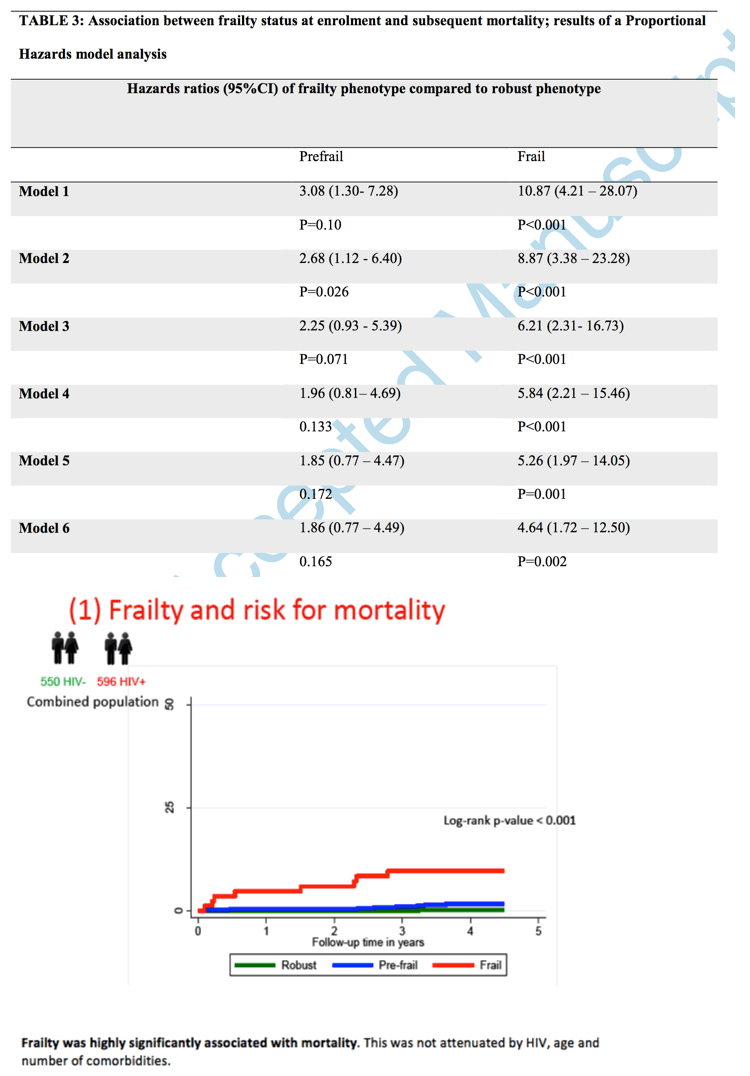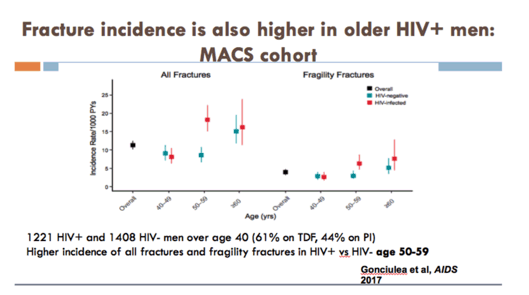| |
Frailty & 5x Higher Mortality in HIV+ Women (WIHS) & Men (MACS) with HIV; frailty doubles fracture rate in older women with HIV; Ever opiate or cocaine use was also associated with increased risk
|
| |
| |
Download the PDF
• Increased risk of both mortality and incident comorbidity among frail HIV-positive and HIV-negative participants and increased risk of frailty progression in those with HIV.
• Older Men HIV+ Over 60 in MACS: 50% had a fall, double seen in HIV-neg older men which is 20%.
In fully adjusted analyses, frailty remained strongly associated with death (HR 4.6,1.7-12.5) and incident comorbidity (OR1.9,1.1-3.1).
The majority of the participants were MSM and of white ethnicity. Frail participants tended to more frequentlybe HIV-positive, older, a current smoker, and to have more pre-existingcomorbidities. Mortality rates/1,000 PYFUwere notably higher among those who were frail 25.7(95%CI,14.2-46.4) compared to those who were either prefrail (7.2 (95%CI,4.7-11.2) or robust(2.3(95%CI,1.1-4.9), p<0.001for both comparisons). Among our virologically controlled HIV-positiveparticipants, most markers of HIV disease stage or a panel of immune activation and chronic inflammation biomarkers were not significantly associated with mortality. CD4 nadir, a previously reportedrisk factor for mortality,[24]was associated with a 50% reduced survival per 100 cell decrease
However, they reported less alcohol use.Levels of hsCRP, D-dimer, sCD163 and I-FABP were higher among frail participants. The majority of the HIV-positive participants used cART (95.8%) of whom 95.1% were virologically suppressed (definedas HIV RNA<200 copies/mL) in the year prior to enrolment. Median time since HIV-1 diagnosis was 12.0 years(Table2).....At baseline 7.5%(n=86)of participants were frail.
Prevalence and 1-year incidence of frailty among women with and without HIV in the Women's Interagency HIV Study....http://www.natap.org/2018/HIV/013019_02.htm
"The overall prevalence of frailty was 11.5% (n = 161/1404); 10.0% (n = 103/1025) among women with HIV and 15.3% among women without HIV (n = 58/379). Frailty prevalence was higher for women without HIV compared with women with HIV for all age groups except 55-59 years 14% (Fig. 1a)....
The HIV frailty study I just emailed reported 22% frailty (29% women, 19% men at average age 60) THIS paper below reports 23% for HIV- in 75-79 Age Group suggesting 15 years earlier onset "Accelerated aging or premature aging"? Frailty screening, prevention & care must be integrated into HIV care as part of restructuring the HIV healthcare system with the population of PLWH aging quickly - 75% expected to be over 50 soon.
WOMEN IN WIHS 40 years old - FRAILTY DOUBLES FRACTURE RATE....Ever opiate or cocaine use was also associated with increased risk
AGE: Frailty Predicts Fractures Among HIV-infected and Uninfected Women: Results from the Women's Interagency HIV Study - (09/17/18)

From Jules: frailty among HIV+ women in WIHS increased by almost double the risk for fracture. Ever opiate or cocaine use was also associated with increased risk. Feelings of exhaustion increased feature risk, so did reduced grip strength, and unintentional weight loss which might be reflective of declining health & exhaustion. Being Black or latino increased risk compared to whites, so did current smoking. One questioner asked if frailty among HIV+ men increased fracture risk and the response by Dr Sharma was probably, and yes of course I agree its likely many of these risk factors here apply to men as well, and frailty increases fall and fracture risk. Bone mineral density has been found to decline more quickly in HIV+ women vs HIV+ men. Of note you will see in graph below that after age 50 fracture rates increase a lot more quickly among HIV+ men & women than for HIV- showing the greater fracture risk older aging HIV+ face. New fractures in HIV+ women is greater in WIHS compared with HIV-, see graph below. Fractures incidence is also higher in MACS HIV+ men vs HIV- and also appears to increase more quickly after age 50, see graph below. A question for HIV is if recovery after fracture in older HIV+ is much more difficult than for HIV-, this remains unresearched and unanswered. It is one of the questions, more patient focused type of research in aging & HIV we need.
AGE: Aging and Falls & Fractures in HIV+ - (10/15/18)
Older Men HIV+ Over 60 in MACS: 50% had a fall - this is double seen in HIV-neg older men which is 20%......AND HIV+ who are taking MORE medications are more likely to fall
older HIV+ are experiencing increasingly higher rates of frailty particularly as they get older, 1 Italian study found 63% frailty in over 65 HIV+, other studies find 15-20% but frailty rates in HIV+ are much higher than in HIV-neg, particularly as they age

|
|
| |
| |
|
|
|